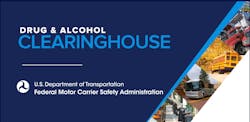Technology enablers driving drug testing compliance for trucking
By Saurabh Kelkar and Hannah Pickering, CloudMoyo
Across the transportation industry, there are two constants: regulatory change is inevitable, and safety and compliance will also be a top priority.
From the perspective of a fleet owner and operator, there have been a recent safety-related regulatory updates that are causing waves of discussion and response within the industry: The Federal Motor Carrier Safety Administration’s drug and alcohol Clearinghouse going live in January, and the recent update to the random drug and alcohol testing rate.
While these changes can seem like a hassle to adjust to, it’s worth looking into the potential long-term impacts that they (as well as effective drug and alcohol testing as whole) can have on safety. The most successful way we see this happening is by leveraging the technologies today that offer end-to-end drug and alcohol testing, ranging from planning and scheduling to recording of test results.
What is the FMCSA Drug and Alcohol Clearinghouse?
The word is out: the FMCSA’s drug and alcohol clearinghouse is live. With the clearinghouse, the FMCSA hopes to increase visibility for employers and drivers. Companies can now quickly pull clearinghouse reports that show positive drug and alcohol test results for drivers. Throughout the lifetime of the driver (through changes in employers or contract work with different carriers), each employer will be able to access the driver’s positive test result records dated after Jan. 6.
While at first glance, the clearinghouse seems like just a compliance hassle for fleet owners, the reality is that its creation highlights the increasing importance of data visibility in the transportation industry, not just in regard to visibility for shippers, but visibility for employers and for employees. With this visibility, employers are better equipped to comply with federal requirements and rest assured that the drivers they are sending out to drive on the nation’s roads are fully qualified for the task at hand.
Beyond the Clearinghouse
The clearinghouse only represents a small part of drug and alcohol testing compliance for fleet owners and operators. From randomized scheduling of drug tests and on-duty driver inspections for CSA records, there is a continuous, never-ending need to ensure consistent, compliant, and—ideally—efficient drug and alcohol testing.
In December, the FMCSA announced that they are increasing the random drug and alcohol testing rate to 50% in 2020 (up from a prior 25%). This will forge a path towards optimal safety, but in order to ensure this, carriers will need to possess the flexibility and system configurability to respond to these changes and requirements in the most efficient manner possible.
Testing can be a complex process, requiring management of a lifecycle of testing, starting with planning and scheduling tests, to recording results with regulatory bodies like FMCSA.
At the end of the day, one of the most critical requirements for compliant drug and alcohol testing is randomized testing. Depending on the size of your fleet and your number of drivers, manually creating pools can be quite overwhelming. While testing for a new driver may be more intuitive, over the lifecycle of your workforce, you want to make sure that you’re conducting randomized testing and aren’t missing any applicable deadlines.
Technology driving testing, safety
While technologies today are driving efficiencies in many aspects of workforce management, their application in drug and alcohol testing in terms of driving compliance without compromising valuable time and resources is an exciting but often overlooked potential.
For example, think about the testing that is conducted on drivers over the course of their employment, or as long as they are engaged in safety-sensitive duties. A simple tool like SMS, e-mail or in-app notifications and alerts can be a game-changer when it comes to making sure you’re up-to-date on all testing needed before sending your drivers out on the nation’s road.
Another use case would be guaranteed generation of randomized testing pools when scheduling drug and alcohol tests and on-duty driver inspections for CSA records. Automation machines that can do the heavy lifting for you, providing a more accurate method of meeting compliance, avoiding the errors that arise when this process it 100% manual.
The third technology enabler that we’ve seen is streamlined, cloud-driven records management. Having a single source of truth where all relevant updates to a driver’s file can be stored and keep as up-to-date as possible creates visibility and accessibility across departments and hierarchies in your organization. this helps everyone from your onboarding team, to safety and compliance-related employees to enjoy a more streamlined compliance lifecycle.
3 tips to achieving success in technology-driven drug and alcohol testing
It’s one thing to identify what technologies your own organization can deploy to change the face of drug and alcohol testing and drive safety practice. Here are some tips to making this journey more successful:
Tip #1: Apply the level of visibility that the clearinghouse is bringing across your organization.
Driving safety should always be a No. 1 priority, and this is easier to achieve when your systems can interface with each other, when you have visibility into safety-related and testing data across departments, and are using a single source of truth (i.e. cloud technologies) to store, secure and analyze this data. This is key to tracking your safety metrics.
Tip #2: Don’t just store and report on your testing data. Explore what’s beyond that.
This is just scratching the surface of testing efficiencies and overall safety success. Data-driven transportation companies today are identifying ways to harness data analytics and identify trends, patterns, and areas requiring attention in their driver testing data. AI and ML technologies are two enablers that are especially driving this approach today.
Tip #3: Empower your drivers by building a safety-first culture.
It’s not enough to enforce safety rules and conduct drug and alcohol testing. Truly successful workplaces that foster a culture of safety instead take this a step further. They’re driving safe work practices by communicating with their employees about why this is important, providing training programs, seeking feedback on what is and isn’t working, and ensuring that systems and processes are in place that give visibility to a driver into their own test records.
Saurabh Kelkar is a Product Marketing Specialist at CloudMoyo, a software company that empowers transportation companies to gain greater insights, unlock efficiencies, and improve agility in operations, revenue and asset management, as well as critical areas of safety, workforce management, and maintenance. He leads the product marketing strategy and roadmap for transportation solutions at CloudMoyo, and has an avid interest in digital developments and opportunities within the greater transportation industry.
Hannah Pickering is a Marketing Specialist at CloudMoyo, a software company that empowers transportation companies to gain greater insights, unlock efficiencies, and improve agility in operations, revenue and asset management, as well as critical areas of safety, workforce management, and maintenance. Hannah is passionate about writing about all things at the intersection of transportation and technology, specifically identifying innovative ways to harness digital enablers to empower transportation companies forward in their digitalization journey.


